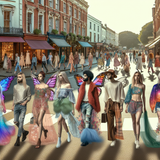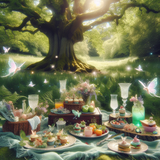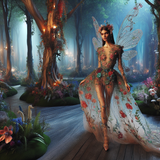The ancient Slavs believed in and celebrated many supernatural creatures that existed in nature. The demonic creatures which were part of the Slavic mythology can be divided into several categories. Most of the Ethnology and Literature scientists agree that fairies belong to the demon group of supernatural creatures in the Southern Slavs mythology. The fairies can be further classified from the top circles of heaven to the bottom of the underground. The mythological existence of fairies is an important part of the traditions and literature of ancient times. Let’s have a look at the magical creatures from Russian folklore.
Vila
A Vila is a Slavic fairy comparable to a nymph and is portrayed as a beautiful woman with long blonde hair. There are three kinds of Vile: those who live on land and forests, cloud or air nymphs, and water nymphs. Legend says that a Vila may appear in the form of a swan, horse, falcon, wolf, or a whirlwind. It is said that air fairies roam the clouds at night, making a loud noise of pipes and drums, and if someone called out to them, he would get stricken by disease, dying within a year or two.
Vila is usually good-natured but can be vengeful if someone insults her or disregards an order. In the Czech tradition, Vile are portrayed as evil unless avoided and respected. They are beautiful women with flowing long hair who live in marches, forest clearings, or the woods. It is said that the Vile would try to entice men who wandered into their land with their melodious voice and striking appearance—believed to live in groups, Vile dance in circles trapping people who joined in their hypnotic dance.
Legend says that Vile liked riding horses and stags, would go hunting, dance in circles, and seek the affection of strong, handsome men. They are said to possess supernatural and healing powers. Known to build castles at the edge of clouds, they would confuse the spirits of men with their arrows. Stories tell that Vile would steal children and replace them with changelings. In Slovakia, they are said to be the restless souls of deceased girls.
Vodyanoi
The Vodyanio is often depicted as an amphibian, in contrast to its Western counterparts that resemble human beings. Some sources claim that it takes the form of an older man with a protruding belly. It is known to live in a castle underwater, under a whirlpool, or near an abandoned water mill. Known to look down on people who disobey his rules, Vodyanio controls the streams of water. He is described as a dangerous creature, for he is known to pull people who bathe in his area to a watery death. Legend has it that he marries women that drown, and if his new bride displeases him, her body is found floating on the water.
Domovoi
Known as a generous spirit, the Domovoi is the keeper of the dwelling and its belongings. His appearance is that of a leprechaun, a frail older man with a long beard. The Domovoi is born old and lives his life in reverse, meeting his death as a newborn. It is known to live in crevices behind the hearth, in the attics, below the porch, or in other hiding places. As the guardian of the dwelling, he takes care of its occupants and defends them against evil spirits and harm. Stories tell that the Domovoi would get upset if the house is not well-kept or if the occupants fight among each other, and he would show his displeasure with terrifying and unexplained noises.
Bacoo
A Bacoo is known to be a mischievous mythological spirit found in the Caribbean. They are believed to live in empty corked rum bottles that float in the Caribbean Sea. Said to have magical powers, a Bacoo bears a resemblance to a leprechaun from Celtic mythology. It has a dwarf-like appearance and rewards its owner with wishes. Other cultures have a similar impression of mischievous folklore characters, like Alladin’s ‘Genie of the Lamp.’ A Bacoo is known to answer the wishes of his owner if kept happy with a daily ration of milk and bananas. He is believed to be a trickster that can transform himself or become invisible to mess with people around him.
Kikimora
Kikimora is a female house spirit who is believed to be the wife of Domovoi. Some stories describe her as a deformed, elf-like, small woman, while some say she was a fair maiden with a beautiful, long braid. The Kikimora is known to have several physical deformities and haunt the dwellings where a child has died. They live in crevices behind the hearth, under the floorboards, behind large brick stoves, or in the attics. The folklore of some regions says that the Kikimora lived in swamps and forests. They are known to be elusive and creatures of mischief, making subtle to disturbing noises to disturb the humans and animals living inside their dwellings. Sometimes, they would leave wet footprints on the floor.
Folklore of Russia originates from Russia and other ethnic groups, and their roots lie in the pagan beliefs of the Slavs that are now represented in Russian fairy tales. Many such tales and bylinas have been adapted for feature movies and animation films. Some Russian poets made poetic interpretations of classic fairy tales.







